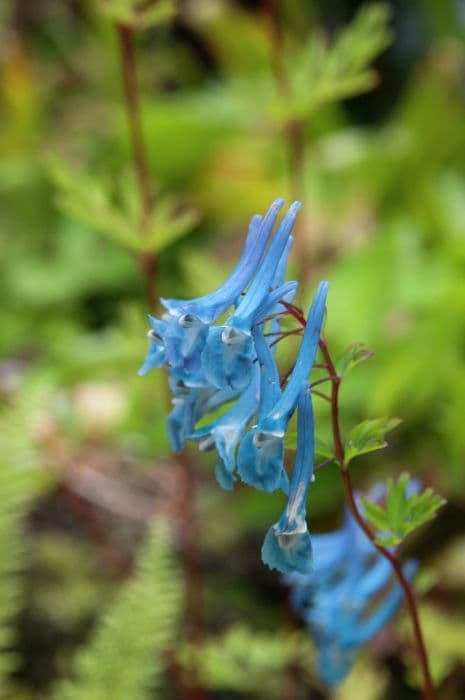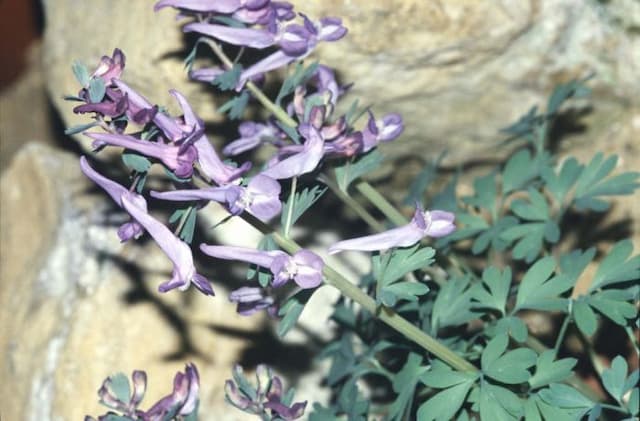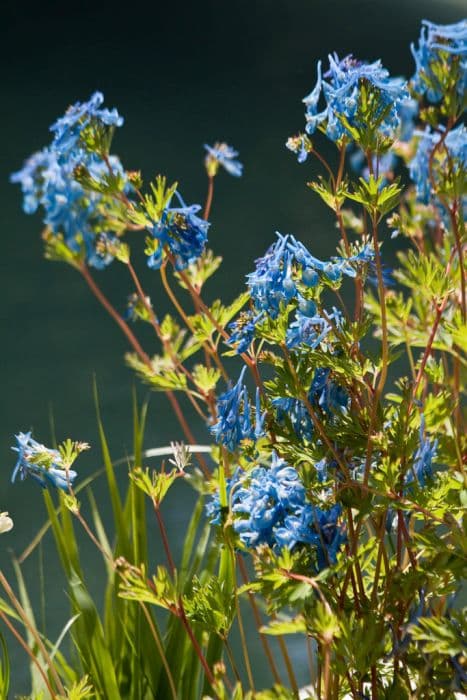Oriental Poppy Papaver (Oriental Group) 'Forncett Summer'

ABOUT
The Oriental poppy 'Forncett Summer' stands out in the garden with its large, showy flowers. The blooms are a strikingly deep pink to salmon color, often with darker spots at the base, providing a beautiful contrast against the light center. The petals have a satiny sheen and a delicate, crepe-paper-like texture, which adds to their allure. Each flower has a prominent, dark purple to black blotch at the base, lending an eye-catching detail. At the center of the flower, there is a cluster of dark, almost black stamens that surround the ovary, which becomes more visible as the flower petals open fully. The flowers are borne on sturdy stems, which are covered with coarse, bristly hairs. The leaves of 'Forncett Summer' are deeply cut, fern-like, and of a blue-green color. They provide a beautiful backdrop to the stunning flowers and form a clump at the plant's base. The foliage can be quite dense, creating a lush appearance in the garden. During the flowering season, the Oriental poppy 'Forncett Summer' adds vibrant splashes of color, and the impressive blooms can become the focal point of any garden display.
About this plant
 Names
NamesFamily
Papaveraceae.
Synonyms
Oriental Poppy, Forncett Summer.
Common names
Papaver (Oriental Group) 'Forncett Summer'
 Toxicity
ToxicityTo humans
Oriental poppy, as a member of the genus Papaver, may contain toxic alkaloids in all parts of the plant. While ornamental poppies are often bred more for their aesthetic qualities than their alkaloid content, it is generally advised to avoid ingesting them due to potential toxicity. Symptoms of poisoning can include nausea, vomiting, drowsiness, and respiratory depression. If large quantities are consumed, the consequences may be more severe. Always seek medical attention if ingestion occurs and poisoning is suspected.
To pets
Oriental poppy may present a risk of toxicity to pets if ingested. Similar to its effects on humans, the plant can have poisonous components which may cause symptoms such as drooling, vomiting, loss of appetite, drowsiness, and incoordination in pets. More severe effects can occur if a pet consumes a large amount of the plant. Pet owners should monitor their pets around ornamental poppies and contact a veterinarian immediately if they suspect their pet has ingested any part of the plant.
 Characteristics
CharacteristicsLife cycle
Perennials
Foliage type
Deciduous
Color of leaves
Green
Flower color
Mixed
Height
2 feet 6 inches (76 cm)
Spread
1 foot 6 inches (46 cm)
Plant type
Herb
Hardiness zones
3
Native area
Central Asia
Benefits
 General Benefits
General Benefits- Aesthetic Appeal: Produces large, colorful flowers that enhance the visual beauty of gardens.
- Attracts Pollinators: Flowers attract bees and other beneficial pollinators, supporting local ecosystems.
- Drought Tolerance: Once established, it is relatively drought-resistant, making it suitable for xeriscaping.
- Low Maintenance: Requires minimal care beyond the initial planting, ideal for gardeners seeking low-effort plants.
- Perennial Growth: Returns each year, providing long-term value and reducing the need for annual replanting.
- Cold Hardy: Can withstand cold temperatures, making it suitable for a range of climates.
- Deer Resistant: Less likely to be eaten by deer, which can be helpful in areas where deer are common pests.
- Vivid Coloration: Adds a pop of color to garden borders and beds, with hues that can complement a variety of garden designs.
- Soil Adaptability: Can thrive in a broad range of soil types, provided they are well-draining.
 Medical Properties
Medical PropertiesThis plant is not used for medical purposes.
 Air-purifying Qualities
Air-purifying QualitiesThis plant is not specifically known for air purifying qualities.
 Other Uses
Other Uses- Poppies can be used as a natural dye source, imparting colors from yellows to rusty browns depending on the mordant used.
- The seeds of the poppy can be used for bird feed, attracting a variety of species to your garden.
- Papaver petals can be pressed or dried for decorative crafting purposes like in scrapbooking or decoupage.
- The stems and seed pods of poppies can be utilized in dried floral arrangements for long-lasting decoration.
- Poppy flowering plants are beneficial for pollinators, providing a food source for bees and butterflies.
- Seed pods from poppies can be used artistically in jewellery making, especially in the creation of unique, natural pendants or earrings.
- The dried seed heads of poppies can be used in children’s craft projects, such as creating rattles or adding texture to collages.
- A poppy patch in a garden can function as a natural method for soil improvement, as their roots can help break up compacted ground.
- The opulent colors of poppies make them suitable for use in photography, offering a vibrant natural backdrop or subject for outdoor portraits.
- In certain educational settings, the lifecycle of a poppy can be a teaching tool to demonstrate plant growth, reproduction, and pollination to students.
Interesting Facts
 Feng Shui
Feng ShuiThe Oriental poppy is not used in Feng Shui practice.
 Zodiac Sign Compitability
Zodiac Sign CompitabilityThe Oriental poppy is not used in astrology practice.
 Plant Symbolism
Plant Symbolism- Sleep and Peace: The Papaver genus, commonly known as Poppies, has long been associated with sleep due to the sedative effects of some species' sap. 'Forncett Summer,' a variety of Oriental Poppy, inherits this symbolism. It's often used to represent restfulness and a state of tranquility.
- Remembrance: Poppies are widely known as a symbol of remembrance, especially for fallen soldiers in war, due to their proliferation on European battlefields after World War I. This symbolism can extend to the 'Forncett Summer' variety as a way to honor and remember those who have passed.
- Beauty and Resilience: Oriental Poppies, including 'Forncett Summer,' are admired for their vibrant and large blooms. They symbolize both beauty and the ability to withstand challenges, as they return each year after lying dormant through winter.
 Water
WaterOriental Poppies, such as 'Forncett Summer', should be watered deeply once a week, allowing the soil to dry out slightly between watering sessions. In the absence of rainfall, provide about 1 gallon of water per square foot every 7 to 10 days. It's crucial to avoid overwatering, as these plants prefer well-drained soil and cannot tolerate waterlogged conditions. During the peak of summer, if the weather is particularly hot or dry, you may need to water more frequently. Always check the top inch of soil for dryness before watering.
 Light
LightOriental poppies like 'Forncett Summer' thrive in full sun locations where they can receive at least 6 to 8 hours of direct sunlight each day. These plants are best positioned in a spot that ensures morning sunlight and can tolerate some partial shade in the afternoon, especially in hotter climates. Avoid deeply shaded areas, as insufficient light can lead to weak growth and fewer blooms.
 Temperature
TemperatureOriental Poppies such as 'Forncett Summer' are cold hardy and can tolerate winter temperatures as low as -30°F, while their optimal growing conditions are in temperatures ranging between 60°F and 75°F during the growing season. They can survive summer highs up to 90°F but may go dormant if temperatures rise consistently above this range.
 Pruning
Pruning'Forncett Summer' Oriental Poppies should be pruned back after the flowering has finished, usually in late spring or early summer. This pruning encourages healthy foliage growth and can sometimes stimulate a second, smaller flush of blooms later in the season. Remove spent flower stems down to the base and cut back any damaged or dead foliage. Pruning can be done annually, timed with the post-bloom period.
 Cleaning
CleaningAs needed
 Soil
SoilThe Oriental Poppy 'Forncett Summer' thrives in well-draining soil with a pH range of 6.0 to 7.0, ideally consisting of a mix of loam, sand, and compost to facilitate drainage while providing nutrients.
 Repotting
RepottingOriental Poppies 'Forncett Summer' are not typically grown in pots and thus do not require repotting; they're perennial and prefer to be left undisturbed once planted in the garden.
 Humidity & Misting
Humidity & MistingOriental Poppy 'Forncett Summer' prefers moderate humidity but is quite adaptable and can tolerate the drier conditions typically found in temperate climates.
 Suitable locations
Suitable locationsIndoor
Ensure full sun, well-draining soil, and room for growth.
Outdoor
Full sun, well-drained soil; protect from strong winds.
Hardiness zone
3-7 USDA.
 Life cycle
Life cycleThe Oriental Poppy 'Forncett Summer' begins its life as a seed, which, when sown in fertile, well-drained soil and exposed to full sun to partial shade, will germinate. After germination, the seedling establishes a small rosette of leaves at ground level. As the plant matures, it develops a deep taproot and a larger clump of hairy, deeply lobed green leaves. In late spring to early summer, tall stems rise above the foliage, topped with large, vibrant orange or salmon-pink flowers with black or dark purple centers. After blooming, the plant sets seed in a capsule, which can be collected for propagation or allowed to self-sow in the garden. Following seed set, the foliage dies back, and the plant enters a period of dormancy during the hot summer months, with growth resuming in the fall.
 Propogation
PropogationPropogation time
Late Summer
The Oriental Poppy 'Forncett Summer' is commonly propagated by seed. To sow the seeds, one should ideally wait for the fall or early spring when the temperatures are cool. Seeds can be scattered directly onto a well-prepared seedbed in the garden, as they need light to germinate, and should not be covered with soil. Instead, press them gently into the earth. The area should be kept moist until germination, which usually takes 10 to 20 days. Once the seedlings have developed true leaves and reached a robust size, they can be transplanted to their final positions in the garden, with ample space for growth. This method banks on the profusion of seeds produced by the plant and is favored for its simplicity and effectiveness.









